You head into your utility room and see water on the floor, oh no! After a quick look around you see that it is coming from your water softener salt tank overflowing, what do you do?
A water softener brine tank will overflow when the brine shut-off float fails to shut off the water feed, the water softener did not draw all the brine from the tank during regeneration, the brine valve does not shut off correctly, or water is leaking down the brine line from the control valve.
An overflowing water softener brine tank does not necessarily mean that your water softener needs to be replaced, let’s stop the overflowing and then look at problems that you may be able to fix yourself without having to replace the entire water softener.
8 Common Causes of a Water Softener Brine Tank Overflowing!
| Cause | Why your water softener brine tank is overflowing | How to fix it |
|---|---|---|
| Clogged Brine Screen or Injector | A clogged brine screen or injector will not be able to draw out the brine from your brine tank and your water softener will keep adding more water to the tank until it overflows. | Clean or replace your brine screen or injector. |
| Sticking Brine Float | A brine float that is not opening and closing correctly can leave brine behind after a water softener regenerates. Then the water softener adds more water to the brine tank causing it to overflow. | Clean or replace brine float assembly. |
| Brine Float Is Set Too High | If a brine float is set too high, the water softener will add too much water to the brine tank which can make it overflow. | Check your owners manual to set brine float to proper height. |
| Dirty Brine Float | Debris on a brine float may cause it to not shut off correctly and the water softener will continue to add water to the brine tank and make it overflow. | Clean or replace brine float assembly. |
| Kinked or Restricted Drain Line | If the drain line of your water softener is kinked or restricted, the water softener will not have a strong enough water flow to create enough draw to use all of the brine from the brine tank. Then the water softener will add more water to the brine tank causing it to overflow. | Straighten drain line and remove restriction. |
| Worn Main Piston | As a water softener piston wears, water can get past the seals of the piston and continue to send water to the brine tank when it should have stopped causing it to overflow. | Replace piston and seals. |
| Leaking Brine Valve | A leaking brine valve that does not shut off completely will continue to add water to the water softener brine tank and eventually overflow the brine tank. | Replace brine valve. |
| Low Water Pressure | Low water pressure may cause the water softener to leave brine in the brine tank after regeneration and then the water softener will add more water to the brine tank causing it to overflow. | Check incoming water pressure and pressure tank. |
How to stop your brine tank from overflowing?
First of all, if your brine tank is overflowing right now, let’s bypass the water softener to stop it from overflowing.
There should be a bypass connected to the water softener directly behind the unit where the system’s plumbing goes into the system.
There are a few different types of bypasses that you may have. Look at the back of your water softener to determine which one you have and put the system in bypass.
Once you have your water softener in bypass, it may take several minutes before the brine tank stops overflowing because the system is under pressure. Once the system has depressurized, the water should stop.
Any kind of bypass can sometimes be hard to push or turn, depending on your type of bypass. Do NOT use a hammer or other tool to hit it hard in an attempt to move it.
If you cannot get your bypass to move, shut off your water supply, turn on a sink faucet or flush a toilet, and let the system depressurize. Once the system is depressurized and with the water still off, push or turn your bypass.
How to un-stick a stuck water softener bypass.
If you are still unable to press or move your bypass, you can try giving it MANY LIGHT TAPS with a small hammer or mallet to get it started, but “DO NOT” hit it hard in order to get it to move. If it is totally frozen, leave your water off and call your plumber for help.
You may have a slider-type bypass that is a piston that you can push from side to side to bypass your water softener. Many light taps with a small hammer or mallet will usually get it to move.

There may be a single lever bypass that requires a quarter turn as directed by a small arrow that should be pointing to SERVICE, turn the lever so that it is pointing to Bypass.

These lever bypasses can stick a bit, but with a little muscle, or with many light taps with a small hammer or mallet, you should be able to get it to turn.
How to bypass a water softener with two bypass knobs.
Many water softeners have a dual knob bypass. This is just a set of two valves that will redirect your water before it goes into your water softener.
You just need give these two knobs a quarter turn and your system will be bypassed.
Normally, the knobs or arrows will be pointing in and out of the water softener in the same direction as the pipes going into and out of your water softener.
Once you turn both levers one quarter turn, the water softener will be bypassed and the knobs should look like this.
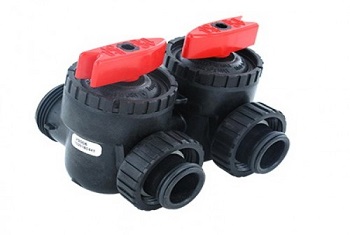
These knobs can be hard to turn at first but after you get them started, they should turn very easily. These knobs will sometimes have an arrow on them or be shaped like arrows, point the arrows towards each other, and your water softener should be in bypass.
Bypassing a water softener with a three-valve bypass.
If you do not see any of these types of bypasses, you may need to bypass the system by turning a few levers on your plumbing. Look for three levers that are usually close to each other, one should be pointing in a different direction than the other two.

Once you’ve located these levers, simply turn all three a quarter turn and your system should be bypassed.
By turning each valve one quarter turn, you will be shutting off two valves that let water into and out of your water softener and opening one valve that will allow water to continue into your home.
Ok, now we’ve got the water bypassed and the overflowing has stopped, what should you do next?
Should I remove the extra water from my brine tank?
If you want to, you can bail out some of the brine or siphon it out, but be sure to dispose of it properly. Saltwater will kill plants, grass, and flowers, so do not get rid of your brine solution anywhere near them.
Even small trees can be affected by saltwater, so be careful where you dump the brine. Or you could use it to melt snow if it is winter time right now where you are.
I highly recommend removing at least some of the extra water from your brine tank once it is working correctly, but in many cases, it is not mandatory.
Once the reason why your water softener brine was overflowing has been fixed, your water softener will draw the extra water from your brine tank and then maintain the correct water level from then on.
OK, Let’s Look Into Why Your Water Softener Brine Tank Was Overflowing.
Your brine injector could be clogged?
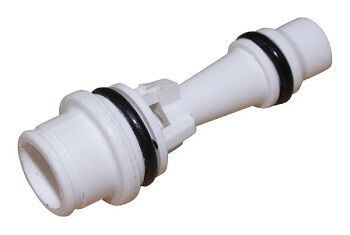
Much like when a drain line is restricted when your water softener’s injector gets clogged up from iron build-up or some kind of debris blocks it, it will not draw the brine solution from the brine tank.
When this happens, the water softener will add water to the tank as usual and it will be more water than it is supposed to be, which could result in a brine tank overflowing.
The injector can be removed and cleaned or replaced. The injector along with a screen is underneath a cap that can be easily removed once the system is bypassed and depressurized.
The injector cap can usually be found in one of five areas. A fleck-type valve will have the screen and injector located to the lower right side of the valve if you are looking straight at the front of the water softener.
The cap will have two screws on it on top and bottom with an o ring on the inside of the cap. Behind the cap, you will find two slots. One with two injectors, one behind the other and the other with a round screen in it.
Where is the injector and screen on a Hague or Waterboss water softener?
On a Hague or Water Boss water softener, the screen and injector can be found behind a cap that is just about right in the front center of the unit, it is square and has four screws holding it in place.
If you don’t have to open this cover, I recommend that you don’t because it sometimes leaks when you put it back on and the cap can crack easily if you try to tighten it.
If you do decide to check under the cap on a Hague or Water Boss system, I suggest that you take the cap off and if it looks relatively clean underneath, just put it back on and do not overtighten.
Any dirt will normally be visible when you take the cap off so you don’t have to take anything out.
Where is the screen and injector in an Autotrol water softener?
An Autotrol water softener will have the screen and injector on the lower left side of the front end of the valve. These are quite easy to remove and clean, just take your time to be sure to put them back in the correct direction.
The Clack valve will have a large round cap on the very top of the water softener that can be unscrewed by hand or with a little help from a pair of adjustable pliers.
But only put the cap back on with your bare hands. Using pliers or other tools to tighten this cap can cause it to clack or make it very difficult to remove the next time that you need to get at the screen and injector.
A few other popular name brand water softeners may have the screen and injector on the top left side or towards the back of the system on the top with a silver metal cover.
Be sure to remove these carefully as they can sometimes leak if you move the rubber seal that is underneath the cover.
How to clean your screen and injector.
Once you have removed the screen and injector, you can use some clean water and an old toothbrush or other soft-bristled brush to lightly clean the area under the cap.
Then you can put the injector in some warm water with a little bit of iron out cleaner, or a few sprays with some calcium, lime, and rust cleaner should do the job.
Let the injector sit in the warm water solution for a good ten minutes or so, and then gently brush off the outside of it and rinse it thoroughly.
You should be able to see a small pinhole going through the center of it.
Do not stick anything into the hole if it looks like it is blocked, blow through it, or use the tip of a paper towel to make sure that it is completely dry, sometimes water inside the pinhole can make it look like it is not clear.
Clean the screen in the same way, soak it in the warm water solution and then gently brush it to clean off any debris, then rinse it thoroughly. Replace the screen and injector as they were, then carefully replace the cap or cover.
Remember to not over-tighten the cap as you replace it as that could result in cracking it.
Now that we have made sure that the screen and injector are clear and free of debris, the water softener should be able to draw all of the brine from the brine tank so that when it goes to refill it, the water will be at the correct level for the proper brine solution dosage.
Your brine float assembly may be sticking.
Where is my brine float assembly?
Did you ever wonder what is inside of that long tube that is inside of your water softener salt tank?
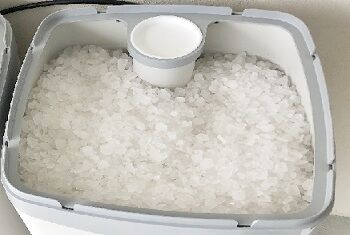
Well, today you are going to find out, it’s your brine float assembly.
I know that’s not as exciting as you might have hoped for, but it is what we want to talk about now.
A water softener brine float assembly is designed to shut off the water going into your brine tank when the water level gets too high to prevent it from overflowing.
Your brine float may not be shutting off the water when filling the brine tank.
Your brine float assembly is simply a float that triggers a valve that is designed to shut off the water going into the brine tank if the water level gets too high.
If your brine tank has overflowed due to the water softener putting too much water into the brine tank, then the brine float did not shut off the water going into the brine tank.
This is often because of something as simple as a tiny spec of dirt getting lodged between the two seals in the valve that shut the water off.
Sometimes the brine float shut off assembly can get stuck in the closed position.
Occasionally, the brine float can stay in the closed position. this can be due to dirt or debris stopping its movement or sometimes salt will re-crystallize on the float causing it to catch on the brine tubes’ sides.
This can keep the float down which will not allow the brine solution to be drawn from the tank and then when the water softener goes to refill the brine tank at the end of its regeneration process, the tank may overflow.
Is the brine float set too high?
The brine float on the brine float assembly is sometimes adjustable. The float is usually just held in place by friction between the float and the rod that it is connected to.
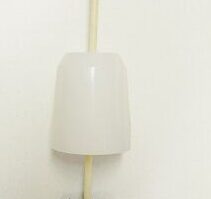
Over time, the float can sometimes wiggle its way up the rod as it gets pushed up when the water hits it and pushes it up.
Check your owner’s manual to find out where the float should be set, and slide it to the correct level.
If you like, you can wrap some tape around the rod to keep the float from going up again, but make sure to use a tape that will stick well and not come apart easily.
Drying the rod off well and using a few wraps of cloth electrical tape seems to do a good job holding the float in place.
You can normally remove the brine float assembly by removing the nut on the outside of the brine tank, right behind the white brine tube.
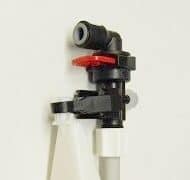
Put the nut aside in a safe place, then push the threaded screw in and gently pull the float up and out of the tube.
How to remove a brine float assembly from your brine tank.
Sometimes there can be salt or debris at the bottom of the float tube that can make it difficult to take the brine float out.
Usually, with a little wiggling, you can work it out and then use a broom handle to break up the salt at the bottom and vacuum it out with a wet vac so you can put the brine float back in without any blockage.
Locate the water shut-off valve on the brine float assembly. It’s a small plunger-looking thing that sits inside a cap at the top of the assembly that is held in place by a red or black clip.
Pull the clip out to the side and then you can twist and pull the top off. Inside there is a simple shut-off valve that may be stuck or may have some debris in it.
Why is my Kinetico water softener brine tank overflowing?
A non-electric Kinetico water softener relies solely on its brine float to stop the water going into the systems brine tank.
Because a Kinetico non-electric water softener has no electric computer to regulate when to stop adding water to its brine tank, if the brine float gets dirty or a small bit of debris prevents the brine float from shutting off the incoming water, the brine tank will continue to fill and eventually overflow.
How to clean your Kinetico brine float assembly.
Use a clean, lint-free cloth to clean the seal and surrounding area until the valve opens and closes easily and makes a good seal when it is closed.
If you have a non-electric Kinetico water softener, the float assembly shut-off is likely to be at the bottom of the float assembly.

This assembly usually just pulls straight up and out of the white tube once you pull the end of it out of the little notch that is cut into the side of the brine tank.
Unscrew the nut at the bottom of the float that is on the end of the float guide, be sure not to lose the o ring that is directly underneath the nut.
Under the cap, you will see a cup that the shut-off sits in. With a clean, lint-free cloth, clean out the cup and the rubber seal at the very end of the float guide.
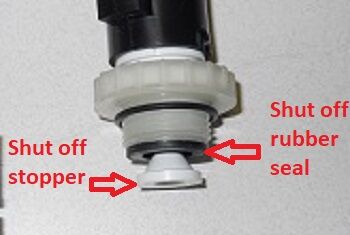
Twist the two seals against each other a bit to make sure you don’t feel any grit between them, and then put the float back together and re-install it. Test that your float shutoff is working when you put the system back into service and keep an eye on it for a few days to be sure the water level does not get higher than it should be.
When your brine float shut-off assembly is working correctly, your brine tank should never overflow unless something actually breaks, like a fitting or a piece of tubing.
The brine float shut-off is the last line of defense against your brine tank overflowing, so if your a do-it-yourself kinda person, you may want to clean and check it annually.
Do you have a kinked or restricted drain line?
Take a look at your water softener drain tubing, are there any kinks or bends that would inhibit the flow of water while the water softener is regenerating?
If the water softener can not drain properly, the system will be unable to use all of the brine (saltwater) in the brine tank and therefore leave some behind.
When this happens, the water softener will still fill the brine tank with the same amount of water as it normally should.
Since there is water left over from before, the amount of water in the tank will be too much and if the brine float shut off does not successfully shut off the water, the water will overflow the tank.
Check for a leaking brine line or brine valve not shutting off.
The tube that goes from your water softener to the salt tank is called the brine line.
If this brine line develops a crack in it or one of the fittings on either end of it becomes loose, water can dribble out and run down the brine line.
When this happens, the water is on the outside of the tubing and will flow down the tubing and into the brine tank.
Even if the brine shut-off assembly successfully shuts off the water going to the brine tank that is on the inside of the tubbing, this water on the outside of the tubing will drip down into the tank and in time will cause the tank to overflow.
Dry off the brine line thoroughly and then check for any cracks in it. Then give the fittings on each end a turn to see if they are loose or perhaps pinching the tubing.
The brine line is just standard 3/8 inch tubing, so go to your local hardware store if you find any problems with it and just replace it. It is relatively inexpensive and easy to replace.
How to replace a water softener brine line.
If you do decide to replace the brine line, be sure to clear off any burrs that may be on the ends of the tubing.
You can use a utility knife or a strong thumbnail to run over the rim of the ends to make sure that they make a good seal when it is connected.
Although it is quite rare for a brine piston to not shut off completely, if a little piece of dirt or grime gets stuck on the rubber seal, it can cause the valve to allow water to seep down the brine line.
When the flow of water going down the brine line is very light, it can be so slow that the brine float assembly will not get enough of a push to shut off the water going into the brine tank.
So this leaking brine valve will continue to drip water into the salt tank until it overflows.
The brine valve is a series of small parts that are compressed together.
It is not something that you would take apart and put back together, and if you did, it may very well leak again or even worse, leak again in the near future and flood the brine tank all over again.
So if the brine valve is not shutting off correctly or if it is just sticking a bit, I highly recommend just replacing it.
It is not hard to do and will give you peace of mind knowing that you should not have any more problems with it.
The water pressure in the house may be too low for the water softener to work.
The standard water softener uses the building’s water pressure to perform its regeneration process.
Even though most water softeners have an electric timer and motor to control the functions of the water softener, it is the water pressure coming from the home that is actually powering what’ is going on inside of the system’s tank.
Most water softeners require a minimum water pressure of 20 psi to properly regenerate the system’s water softening resin.
If the pressure is too low, the water softener will not be able to draw the brine solution from the brine tank, and when the water softener adds more, the salt tank can overflow.
Your main piston may be worn out?
Although not very common, the water softeners control piston seals can wear down, allowing water to seep from one section of the valve’s chamber to another and then trickle down the brine line even after the water softener has completed its regeneration cycles.
If the brine float assembly does not completely have the water shut off at the brine tank, the water will continue to fill, and eventually overflow the brine tank.
To Sum Up!
These are the most common reasons that I have found that can make a water softeners salt tank overflow. I believe that if you check for these symptoms, you will find the reason for the overflow and be able to correct it.
Please do not touch anything on your water softener that you are not sure of or feel uncomfortable touching, a water softener is normally under a great amount of pressure and must be worked on very carefully.
Call your local professional water treatment service person if you do not feel capable of doing anything that I have described.



Would a power flutter during regeneration cause the softener to allow too much water to the brine tank/ Even so I would expect the float valve to shut off the water. Does this make any sense? This is a Culligan system.
Hello Mr. Willard and thank you for the question.
If you lose power while an electric water softener is regenerating, it will stay in whatever cycle that is was in when the electricity went off.
If your water softener was in the brine refill cycle when your electricity went off and then back on again, the water softener may have started the brine refill cycle from the beginning which means that it will put more water than normal into the brine tank. In that case, the brine float should then stop the water once the water reaches the brine float.
If the water softener has added too much water to the brine tank, you could experience some salty water after the water softener regenerates the next time.
If you do, just run the cold water until the salty water is gone and then the water softener should operate normally after that. If salty water continues, you may have a clogged injector which can cause high water levels in the brine tank because the water softener may not use all of the water in the brine tank.
Most of the time, a brief or long-lasting power outage will not create any problems with a standard water softener except that you might have to reset the clock so the water softener will regenerate at the proper time.
I hope this was helpful.
Paul
Have a Morton water softener and after recharge I can hear water running in the softener.
What would be the cause and solution if you can help
Thank you.
Dale Davis
Hello Dale and thank you for the question.
What you may be hearing is the final “Rinse” cycle of the regeneration process. This is when clean water is rinsed through the water softener to remove excess sodium from the water softener resin.
This is often a very quiet sound that some people do not notice even though it has always happened.
If this is an older water softener, it may be the piston not sealing right away after it has returned to its “HOME” position.
This may require having a service person come and replace the piston.
Hope this was helpful.
Paul
At the start of the brine rinse cycle, it puts water into the tank.
Hello Richard and thank you for the question.
Some water softeners use a “DRY” brine tank system where water is only added to the brine tank shortly before the regeneration process to help prevent salt bridging and stagnant water.
I hope this was helpful.
Paul
Hi Paul, had a culligan high efficiency softener installed in my house about a year ago. Still have hard water and they’ve been here 5-6 times now to try and fix that. When they leave they always say “ should be good now “. I went to check the salt level Christmas Eve and found water flowing out the brine tank overflow, water in the house is now just as hard before the softener is installed. It’s not in bypass mode, there is no salt bridge and the dial a softness dial is at its maximum turned out. Not sure if that should be turned in or not. Any suggestions? Thanks in advance!
Ian
Hello Ian and thank you for the question.
I am not very familiar with the latest Culligan “High Efficiency” water softeners as Culligan does not sell any parts for servicing them.
But I believe that your “Softness” dial should be all the way in for the softest water.
These dials are essentially what is called a “Bleeder” valve which is designed to allow just a small amount of untreated water to mix with your softened water to make it somewhat hard.
A problem with these valves is sometimes if you have them open too much, it allows the untreated water to flow into the home as if the water softener was bypassed.
This also means that the water softener will not be metering your water usage and NOT regenerate.
I recommend turning the softness dial all the way in and then manually regenerating the water softener 2 days in a row to thoroughly regenerate the water softener resin.
I think that the water coming from the overflow will stop because the water softener will now regenerate and use the brine from the tank.
I hope this was helpful.
Paul
Hello Paul,
I hope you can help me. I have just (10 days ago) replaced our old 15 litre timed water softener after 11 years of excellent service with a new 10 litre metered water softener from the same company (East Midlands Water Company). The new unit is identical in size and appearance so I expected it to be simple a case of swapping the old for the new unit. Unfortunately I have discovered that during its first regeneration cycle the brine tank does not drain correctly so at the end of the cycle the tank the overflows. I have spoken to the company and they have asked me to check various things including drain hose, the injector and the tube which goes from the transparent float chamber and reaches to the bottom of the tank. There is a filter fitted to the end of the tube. Everything is clear and clean which is what I would have expected from a brand new water softener. With all your experience do you have any suggestions as to what could be causing the problem.
Kind regards David
Hello David and thank you for the question.
This could be a little tricky, but I do have a few suggestions.
Check where the drain line is going out to make sure that the pipe is not clogged or frozen. If you can, run the drain line outside to a clear area that is NOT near any flowers, plants, or trees for now just so you can see if the water does flow out of the drain line.
I have not worked on that exact brand of water softener being from the US but it is an “Autotrol” valve and it should have a shut-off float inside of the brine tank. Check that the float is moving freely and shutting the incoming water off when the float is pushed up.
Since your unit is new I would not expect there to be anything clogged or blocked inside of the unit, but there might be a problem with the computer board. The computer might not be telling the system to stop in the brine draw cycle or it may be in the brine draw cycle for too short of a time.
I don’t know how much water hardness you have, but this unit seems to be a small size. Does the company recommend this unit for your water situation? If they don’t have any answers for you, I would suggest asking them to send you a new computer board or to exchange the entire unit as it should still be under warranty.
Let me know if this was helpful.
Paul